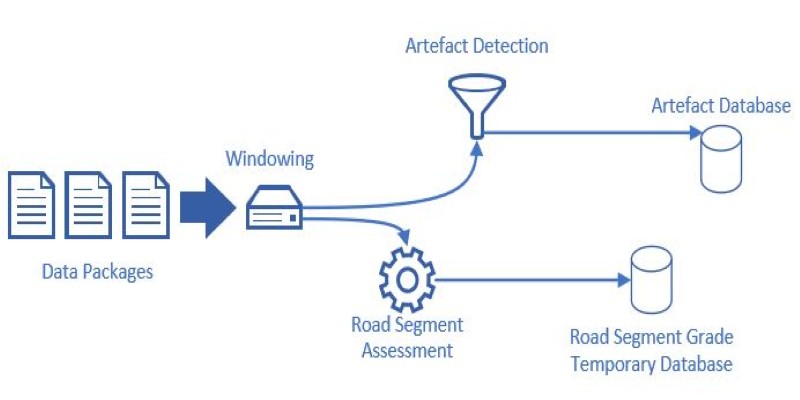Lambda architecture is a data processing framework meant to deal with big data using batch and real-time data processing. It includes three primary parts: the batch layer, used to process massive datasets in batches for precision; the speed layer, used for real-time data for real-time insights; and the serving layer, which blends the outputs from both layers to query.
This mixture of batch and stream processing enables companies to effectively process historical and current data so they can leverage precise, real-time information. Lambda architecture is fault-tolerant and scalable and best suited for apps that need speed and accuracy in processing data.
The Core Components of Lambda Architecture
Lambda architecture has three major components: the batch layer for past data, the speed layer for real-time processing, and the serving layer for querying. It strikes a balance between speed and accuracy in big data applications.
Batch Layer
The batch layer is used to store and process big data sets. This layer processes data already gathered and requires it to be processed in bulk. As batch processing is time-consuming, the area of focus in this case is accuracy and thoroughness, i.e., data is processed and stored properly to be queried later.
The batch layer usually handles enormous data sets, which are usually stored in distributed storage systems such as HDFS (Hadoop Distributed File System) or cloud storage. The data is processed periodically (in hours or days), creating a master data set that is updated continuously.
Speed Layer
Contrary to the batch layer, the speed layer is structured for real-time, instant data processing. It processes information as it takes it in and gives results at near-instant speed. As much as it focuses on delivering speed at the expense of completeness, it helps users get current information without suffering from the lateness associated with batch processing.

Real-time data usually means processing events from devices such as IoT sensors, web transactions, or real-time user activity. The speed layer then quickly processes such events to produce insights almost at once, albeit possibly less holistic than the ones created by the batch layer.
Serving Layer
The serving layer is the interface for querying processed data. It combines the results from the batch and speed layers, making them accessible to end-users. This layer allows businesses to query both historical and real-time data, providing a complete view of the information they need.
By merging the results of the batch and speed layers, the serving layer ensures that data is always available for analysis. Whether users need immediate insights or a comprehensive historical perspective, the serving layer offers the flexibility to retrieve data from both sources.
Why Choose Lambda Architecture?
Lambda architecture provides a unique solution to the challenges posed by large-scale data processing. The hybrid structure allows businesses to address two critical concerns: speed and accuracy. Here are some key reasons why organizations might opt for Lambda architecture:
Scalability: Lambda architecture easily scales to handle growing data volumes, allowing organizations to expand processing capabilities for both real-time data and historical data, ensuring the system evolves with business needs.
Fault Tolerance: Lambda architecture offers fault tolerance by using separate batch and speed layers. If one layer fails, the other continues processing, ensuring data processing remains uninterrupted and reliable.
Flexibility: Lambda architecture allows businesses to leverage both real-time and historical data simultaneously, offering flexibility for in-depth analysis through the batch layer and quick insights through the speed layer.
Cost-Effectiveness: Lambda architecture is cost-effective due to its dual approach, enabling businesses to optimize resources, scale as needed, and adjust processing power efficiently based on data demands.
Challenges of Lambda Architecture
While Lambda architecture has its advantages, it is not without its challenges. The two-layer system—batch and speed—can make it complex to implement and manage. Here are some of the challenges businesses may encounter when using Lambda architecture:
Complexity
Managing two distinct data processing layers requires careful planning and coordination. Ensuring that the batch and speed layers work together seamlessly can be challenging, and any failure in one layer can impact the entire system. Maintaining this complex setup requires skilled personnel and resources.
Consistency Issues
Since the batch layer processes data in bulk over time and the speed layer processes real-time data, discrepancies can arise between the two layers, resulting in temporary inconsistencies in the data. While the serving layer attempts to reconcile these discrepancies, achieving perfect consistency can be difficult, especially in time-sensitive scenarios.
Resource Intensity
Lambda architecture requires significant computational resources to process both real-time and batch data. The infrastructure needed to support both layers can be costly, especially for businesses with limited resources. Additionally, managing and maintaining the system can lead to higher operational costs.
Lambda Architecture in Action
Lambda architecture is used in many industries where processing large volumes of data is crucial. Some examples include:
E-Commerce

E-commerce platforms rely heavily on real-time data to track user interactions and transactions. Lambda architecture enables these platforms to analyze customer behavior in real-time while also using batch processing to assess long-term trends and sales patterns.
Financial Services
In finance, real-time data is crucial for monitoring stock prices, trading activities, and financial transactions. By combining batch and real-time processing, Lambda architecture allows for both immediate insights into market movements and a comprehensive historical view of financial data.
IoT (Internet of Things)
With millions of IoT devices generating data every second, Lambda architecture is a perfect fit for processing the vast amounts of information these devices produce. The speed layer processes real-time data from sensors, while the batch layer aggregates data over time to provide insights into long-term trends.
Conclusion
Lambda architecture provides a robust solution for handling big data by combining batch and real-time processing. Its ability to offer both speed and accuracy makes it ideal for businesses that need scalable, fault-tolerant systems. While it presents challenges in terms of complexity and resource demands, its benefits—such as flexibility and scalability—make it a powerful tool for organizations managing large volumes of data. For companies seeking comprehensive, timely insights, Lambda architecture proves to be an invaluable framework.
